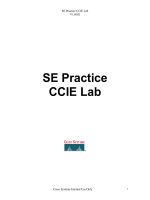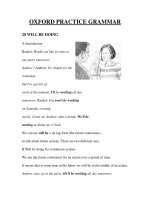Tài liệu SE Practice CCIE Lab docx
Bạn đang xem bản rút gọn của tài liệu. Xem và tải ngay bản đầy đủ của tài liệu tại đây (240.8 KB, 15 trang )
SE Practice CCIE Lab
V1.0GG
SE Practice
CCIE Lab
Cisco Systems Internal Use Only
1
SE Practice CCIE Lab
V1.0GG
E0
Frame Relay
2524
Sleepy
DLCI
101
DLCI
100
2524
Grumpy
S0
E0
S1/1
S1/2
S1/0
S0
Dopey
E0
E0
Physical Layout
Diagram 1
Shorn
DLCI
100
DLCI
102
S1
2511
3620
S0
S0
E0/0
ISDN
2513
Happy
2513
TO 0
TO 0
S0
S1
Cisco Systems Internal Use Only
2
SE Practice CCIE Lab
V1.0GG
Dopey
IP address
171.68.39.15/24
E0
2513
Happy
2524
Sleepy
2513
Shorn
Line 1
Line 2 Line 3
Line 5
3620
Frame-
Switch
Comm Server Setup
Diagram 2
2511
2524
Grumpy
Line 4
Cisco Systems Internal Use Only
3
SE Practice CCIE Lab
V1.0GG
Topology
Diagram 3
E0
ISDN
2524
Sleepy
DLCI
101
DLCI
100
2524
Grumpy
S0
E0
S1
S1/1
S1/2
S1/0
S0
Dopey
E0
2513
Shorn
DLCI
100
DLCI
102
2511
S0
IGRP
RIP
OSPF
area 0
OSPF
area 1
OSPF
area 0
OSPF
area 2
3620
S0
Frame Relay
2513
TO 0
TO 0
area 3
S1
S0
Happy
E0
E0/0
RIP
Lab 1
Communications Server Setup / Network Connections
Cisco Systems Internal Use Only
4
SE Practice CCIE Lab
V1.0GG
• The Communications Server is cabled as shown on the previous
diagram.
• Communication Server port 1 is connected to 2513_1 (Shorn)
• Communication Server port 2 is connected to 2513_2 (Happy)
• Communication Server port 3 is connected to 2524_1 (Sleepy)
• Communication Server port 4 is connected to 2524_2 (Grumpy)
• Communication Server port 5 is connected to a 3620 acting as a
Frame Relay Switch.
• Configure the Communications Server so that when you type the
name of a router on the Server you are connected to the console
port of that respective router.
TIME: 30 minutes
Cisco Systems Internal Use Only
5
SE Practice CCIE Lab
V1.0GG
Lab 2
IP Routing Configuration
The objective of this lab is to configure OSPF/IGRP/EIGRP/BGP/RIP
in different parts of the network and to redistribute routing information.
In the working setup all routers should see every route and should be
able to ping any interface in the network. Do NOT configure static
routes to accomplish this.
Topology and Basic IP Setup
You will be using the CLASS B network 172.17.0.0 with the 3’rd octet
set to 59. Thus all your addresses should look like 172.17.59.X. Ensure
that you conserve as much address space as possible for future
expansion.
Do not use static routes for IP on any router unless explicitly directed.
2.0
Configure Frame Relay switch:
• Configure the frame switch with DLCI’s per the lab diagram.
• Use LMI type Cisco, and encapsulation IETF
• Ports are DCE and the speed should be set to 64K.
2.1
Configure IP across the Frame Relay network:
• Use a 28 bit subnet mask.
• Confirm connectivity across the Frame Relay network by pinging from
Grumpy to Sleepy and Grumpy to Shorn.
• Use sub-interfaces on Sleepy & Shorn. Use “frame-relay map”
statements on Grumpy.
TIME: 30 minutes
2.2
Configure IP across the ISDN link:
• Grumpy is connected to an ISDN simulator on port 1.
• Sleepy is connected to an ISDN simulator on port 2.
• Switch type is NI-1
• Port 1 SPID1: 0835866101 Directory Number: 835-8661
• Port 1 SPID2: 0835866301 Directory Number 835-8663
• Port 2 SPID1: 0835866201 Directory Number: 835-8662
• Port 2 SPID2: 0835866401 Directory Number 835-8664
• Use a 28 bit subnet mask.
Cisco Systems Internal Use Only
6









